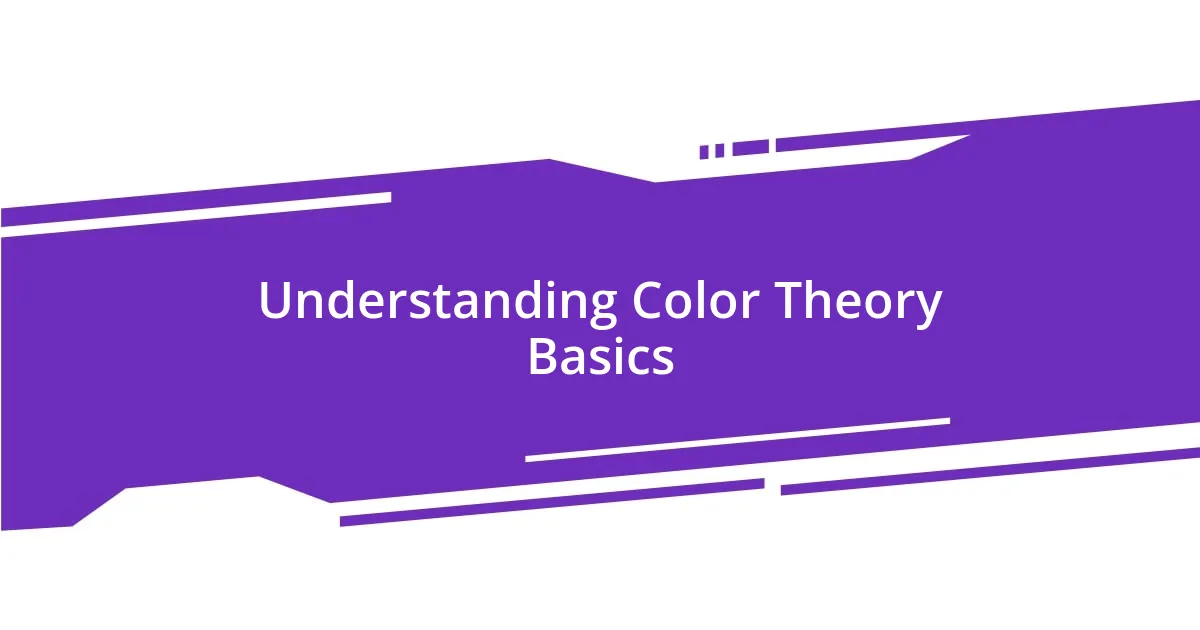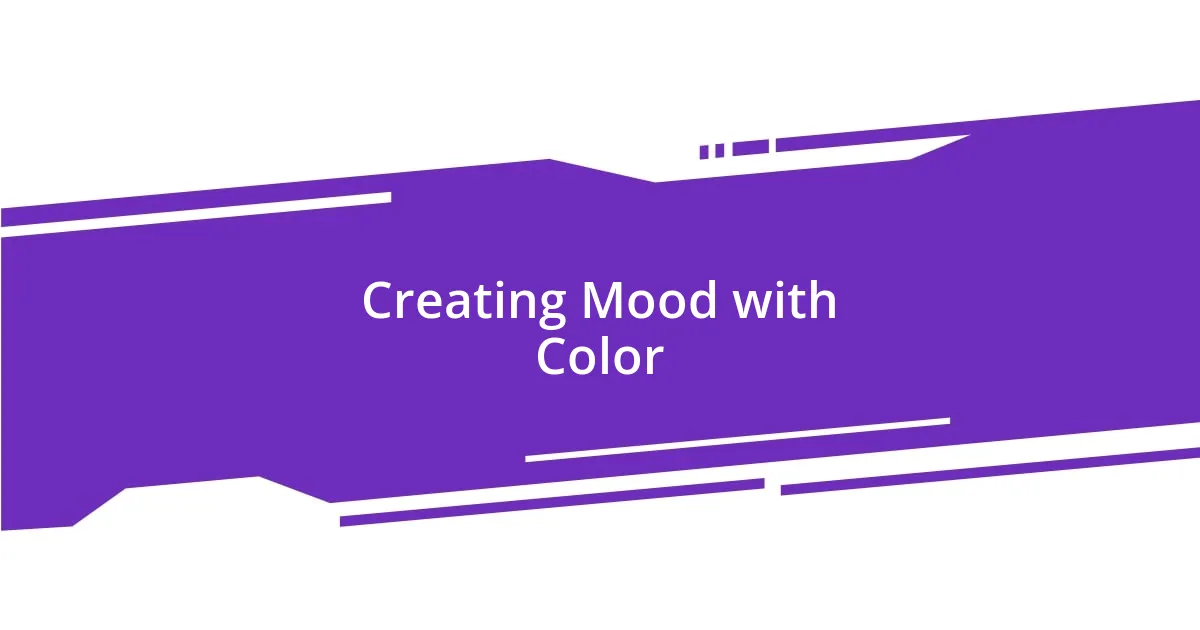Key takeaways:
- Understanding color theory involves recognizing the emotional and psychological impact of colors, guiding artists in creating meaningful artworks.
- Effective color palettes start with identifying the desired mood and applying color theory principles like complementary, analogous, and triadic colors for harmony and contrast.
- Experimentation with unexpected color combinations can lead to surprising and invigorating outcomes, enhancing both the emotional resonance and visual appeal of art.
- Evaluating the impact of color on art reveals its ability to evoke nostalgia and create a rich narrative, influencing the viewer’s emotional connection to the piece.

Understanding Color Theory Basics
Understanding the basics of color theory feels like uncovering a hidden language. It’s fascinating how colors interact; for instance, complementary colors—those directly opposite each other on the color wheel—can create striking contrasts that captivate the gaze. When I first started experimenting with these combinations in my work, I was amazed at how pairs like blue and orange could energize a space, giving it a life of its own.
One key element of color theory is the concept of color harmony, which guides artists to create pleasing color combinations. I remember the first time I tried a monochromatic palette, using different shades of blue to convey tranquility in a piece. The sense of calm it evoked was profound; it made me realize how a simple choice in color could completely alter the emotion of my artwork. Have you ever noticed how certain colors can make you feel happy or nostalgic? That’s the magic of understanding hue, saturation, and brightness.
Don’t overlook the psychological effects of color, either. Colors can spark emotions—red can evoke passion while green often symbolizes growth. I often think about how my art reflects my mood; a vibrant yellow might mirror a sunny day, while darker tones can express melancholy. How do the colors you use in your creations or surroundings impact your feelings? Grasping this connection draws you deeper into the rich, expressive world of color theory.

Choosing a Color Palette
Choosing a color palette is an essential step that defines the essence of any artwork. When selecting colors, I often start with a specific feeling or idea I want to convey. For instance, I once created a piece inspired by a summer evening, where I used warm oranges and soft pinks to capture the sunset’s glow. The moment I applied those shades, it felt like I had transported myself back to that serene place—proof of how deeply colors can evoke memories and emotions.
Here are some steps I consider when choosing a color palette:
- Identify Your Mood: Decide the emotion you want to express.
- Start with a Base Color: Choose one dominant hue that encapsulates your theme.
- Use Color Theory Principles: Explore complementary or analogous colors to enhance your base color.
- Create Variety: Use different shades and tints to add depth but maintain your palette’s harmony.
- Experiment Silently: Try combinations without pressure; sometimes, the best palettes emerge unexpectedly.
By honing in on these basics, I’ve found that my artwork not only tells a story but resonates emotionally with viewers, creating a more immersive experience.

Applying Color Wheel Techniques
Applying techniques from the color wheel is a transformative experience that I deeply appreciate. When I think about applying complementary colors in my pieces, I remember a recent landscape I painted, where the bright, fiery orange of a sunset contrasted beautifully against the deep blue of the ocean. It was exhilarating to see how this dynamic interplay not only drew the eye in but also activated the feelings of warmth and relaxation, as if inviting the viewer to step into that tranquil moment.
Analogous colors, those that sit next to each other on the wheel, have also made a significant impact in my art. For example, when I painted a floral piece using shades of pink, coral, and peach, the soft transition between these colors created a sense of unity and fluidity. I remember my joy as I mixed these hues—each stroke felt like a gentle caress of warmth, enveloping the canvas in a comforting embrace. This cohesive effect made the entire composition feel harmonious and inviting, which is something I strive for in every artwork.
Today, I frequently experiment with triadic color schemes to create vibrant and balanced compositions. Just the other day, I worked on a piece combining red, yellow, and blue. As I layered these hues, their boldness sparked a playful energy that invigorated the whole painting. This spontaneity resonates with me, as it reflects my creative spirit—how do colors connect to your own creative journey? I’ve learned that the interplay of colors can elevate imagination and evoke a spectrum of emotions, turning an ordinary canvas into a captivating story.
| Color Wheel Technique | Description |
|---|---|
| Complementary | Colors opposite on the wheel; create striking contrast. |
| Analogous | Colors next to each other; evoke harmony and unity. |
| Triadic | Three evenly spaced colors; offer vibrancy and balance. |

Creating Mood with Color
When I think about creating mood with color, one of my favorite experiences comes from using cool tones. I once painted a scene of a misty forest at dawn, employing soft blues and greens. These colors immediately set a tranquil atmosphere, almost like a gentle lullaby for the eyes. Have you ever noticed how some colors just seem to wrap you in a moment? That’s the magic of cool hues—they can calm and soothe, inviting viewers to linger a little longer.
Shifting to warmer colors can dramatically change the mood of a piece. I remember a vibrant piece I worked on of a bustling market, where bold reds and sunny yellows dominated the canvas. The energy in those colors created such a vivacious interaction that I could almost hear the laughter and chatter of people around me. It leads me to wonder: how often do you harness that vibrant energy in your own work? That push and pull of colors can ignite a sense of joy and excitement, drawing the viewer right into the experience.
Sometimes, I like to create a more complex emotional landscape by juxtaposing colors to enhance mood. An example that resonates with me is a melancholic piece where I paired somber greys with striking bursts of crimson. This contrast not only captured a sense of sadness but elevated it with a hint of passion. I often find myself questioning how emotions can be visually expressed—what colors do you believe represent feelings like longing or nostalgia? The interplay of these hues doesn’t just convey a story; it elicits a visceral reaction, resonating deeply with anyone who takes a moment to truly connect with the artwork.

Using Contrast and Harmony
Using contrast and harmony in my art has been a game changer. I vividly recall a time when I worked on a cityscape painting. By pairing the bright yellows of streetlights against the deep indigos of the night sky, I created a compelling contrast that made the entire scene pop. It was like a visual dance—each color supporting the other while evoking a sense of wonder in the viewer. Have you ever noticed how contrast can breathe life into your artwork and spark a narrative?
As I dive deeper into my pieces, I’ve found that harmony plays just as crucial a role as contrast. One memorable project involved a serene beach scene where I used variations of soft pastels. The gentle blend of light blues, pale pinks, and sandy beiges wrapped the composition in tranquility, inviting anyone who gazed upon it to imagine the peaceful sounds of the waves. There’s something so satisfying about how harmonizing colors can instill a feeling of unity. Don’t you think that designing with harmony can transform a loud cacophony of colors into a symphony?
I often experiment with the balance between contrast and harmony, finding myself in a delightful tug-of-war. For instance, I once painted a portrait where an earthy brown background was contrasted with vibrant green foliage surrounding the subject. This eye-catching starkness not only drew the viewer in but also created a sense of coziness amid the lively greens. It’s fascinating to consider how these choices impact the viewer’s experience—what kind of emotions do you want your art to elicit? Balancing these elements keeps my creative juices flowing, making each piece an exploration of color relationships that reflect my vision and emotions.

Experimenting with Color Combinations
Experimenting with color combinations has always been one of the most exciting parts of my artistic journey. I remember when I decided to merge unexpected colors like tangerine and teal in a still life composition. At first, it felt a bit risky, but seeing those vibrant hues interact brought an entirely new energy to the piece—like two friends laughing together. Have you ever felt that thrill when colors surprise you? It’s those moments that remind me of how playful color can be, inviting exploration rather than adhering to strict rules.
Another experience that stands out involved revisiting an old painting. I took a soft lavender background and decided to overlay bold orange blossoms. This combination transformed the painting completely. The way the warm orange fluttered against the cool lavender was like a dance of joy, and it truly captured a sunny afternoon in bloom. It got me thinking: how often do we overlook the potential of colors that seem incompatible? Sometimes, stepping outside of our comfort zone can lead to the most delightful surprises.
I frequently set aside time to play with colors without any pressure or expectation. In one of these sessions, I combined a rich burgundy with a soft mint green, something I had never considered before. The result was stunning—a balanced yet intriguing tension that made me smile every time I looked at it. It reminded me that color experimentation isn’t just about aesthetics; it’s about evoking feelings. Have you ever experienced a color combination that moved you in unexpected ways? That’s the beauty of color—it can stir emotions and thoughts, reflecting my inner world in ways words sometimes cannot capture.

Evaluating Color Impact on Art
Evaluating the impact of color on art is an intriguing process that continuously unfolds for me. I once created a piece focused on autumn leaves, where I utilized rich oranges, deep reds, and golden yellows. The moment I stepped back to assess it, I realized how these warm colors not only celebrated the season but also evoked feelings of nostalgia and warmth. Have you ever noticed how certain color palettes can transport you to a different time or place?
In another instance, I worked on a monochromatic piece using varying shades of blue. The calming effect it had on viewers truly surprised me. Each interaction revealed how much people connect with colors on an emotional level—it felt like a shared experience. How do you think colors resonate differently with individuals? I believe this personal connection is what makes color selection so crucial in an artwork’s overall impact.
As I evaluate my choices, I often consider how colors can steer the narrative of my pieces. For example, in a recent painting, I integrated stark blacks and whites alongside vibrant pops of red. This choice created a dramatic tension, leading the viewer’s eye through the piece with intention. It got me pondering: in what ways have you seen color shift the mood or story of an artwork? The right palette, in my experience, can turn an ordinary scene into an extraordinary journey, full of emotion and depth.














